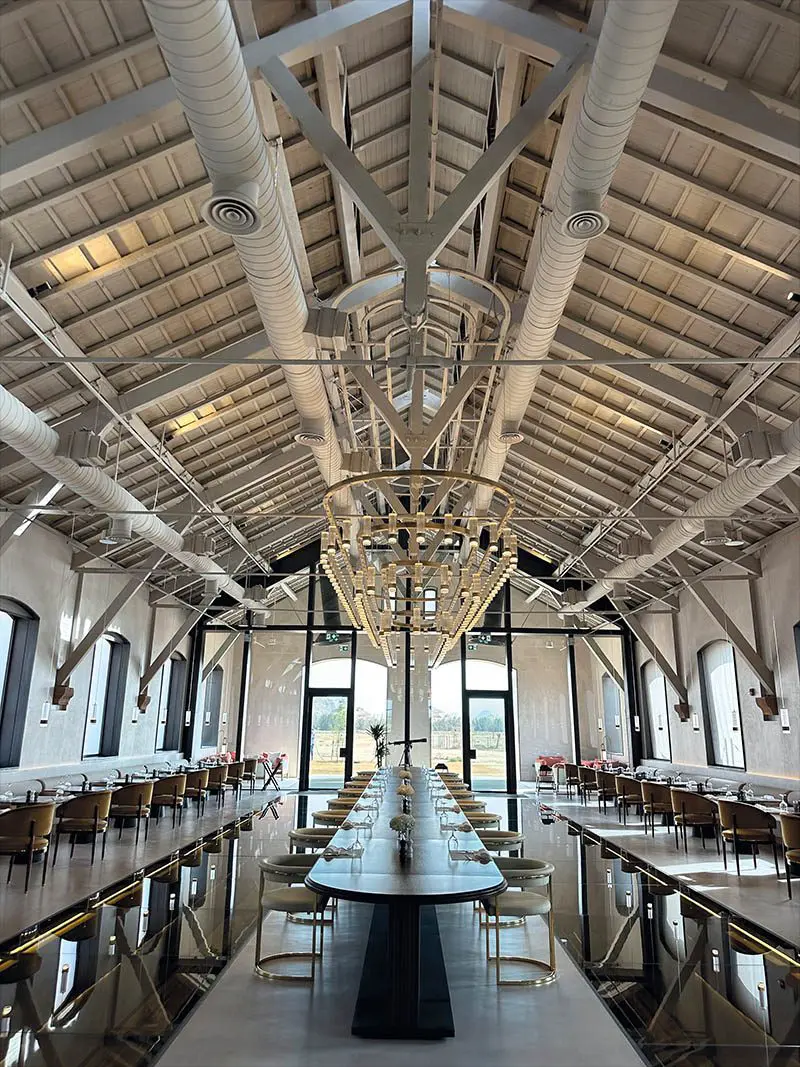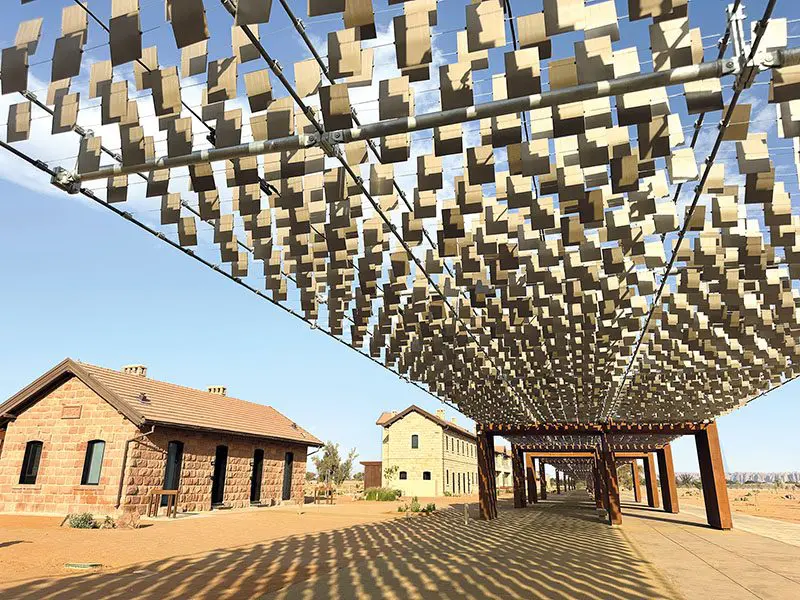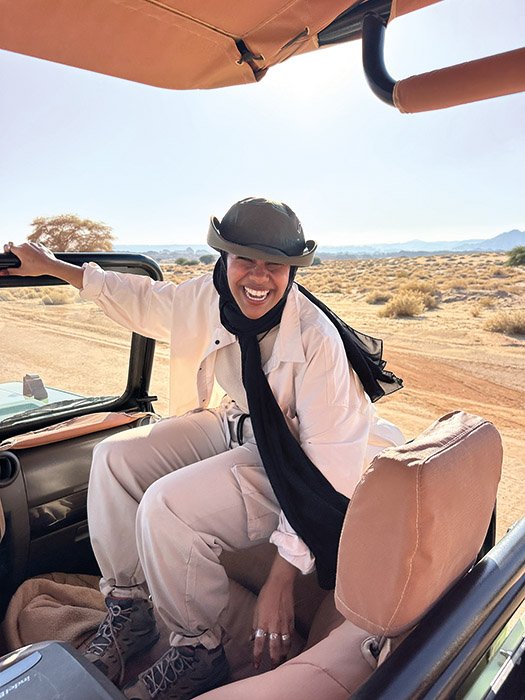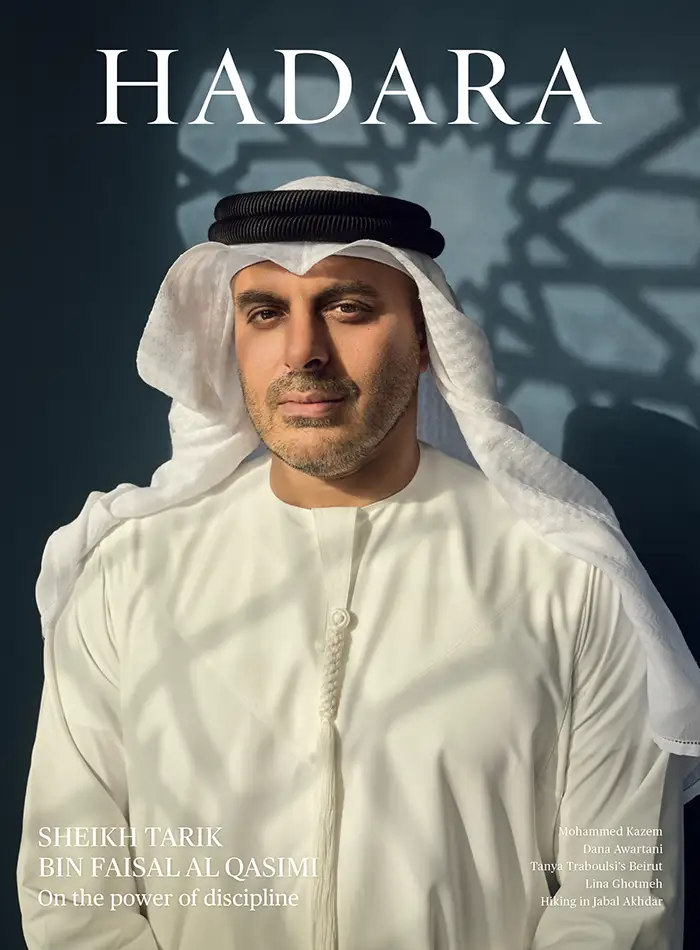The gilded age
An abandoned station on the Hejaz Railway is reborn as an extraordinary hotel.
By Nicola Chilton
The 2,000-year-old Nabataean tombs of Hegra may be AlUla’s big draw, but the natural landscape that forms the backdrop to these ancient masterpieces has a magnetic allure of its own. A new hotel, The Chedi Hegra, has just opened on the edge of the heritage site, offering guests unrivalled access to some of AlUla’s most beguiling scenery.
The Chedi is housed in a collection of stone buildings that were once part of the Hejaz Railway’s Hegra Station. Built in the early 1900s, the 1,300-kilometre railway connected Damascus with Medina, cutting the time it took pilgrims to reach the two Holy Mosques from 40 days by camel caravan to just five by train. The Chedi occupies 15 sensitively restored stone structures stretched along the original tracks. Rooms and suites are sleek and uncluttered with nods to the material aesthetic of the Nabataean tombs and thoughtful details like leather belts adorning the sofas, reminiscent of classic steamer trunks.
“We wanted to incorporate the idea of travel not only as a religious function, but as a cultural way of bringing people together,” says Florian Boje, CEO, co-founder and design principal of Giò Forma, the architecture practice behind The Chedi Hegra and another of AlUla’s iconic modern structures, the shimmering mirror-covered Maraya.

The Chedi Hegra is set amid a spectacular desert landscape. The architects worked to ensure that views of the rock formations could be glimpsed throughout the hotel. Tthe Prima Classe restaurant (above), channels the glamour and nostalgia of luxury train travel. The vast, high-ceilinged space was originally the station’s maintenance depot. Hero image: RCU / Royal Commission for AlUla; Dining room photo: Nicola Chilton.
With its strategic location on pilgrimage and trade routes, AlUla has welcomed travellers for centuries, and its oasis, home to more than two million date palms today, has long provided shelter and sustenance to residents and visitors. Ancient civilisations, including the Dadanites, Lihyanites and Nabataeans, left their marks here in the form of tombs, sculptures and etchings carved in rock and stone. And those dramatic rock formations are everywhere. They’re visible from the hotel’s main reception area, a space housed in a glass box with rammed-earth walls made from local sand, a material developed for the hotel resulting in a textured and tactile finish. They’re there when I wake at dawn to drink tea on my terrace, wrapped up in a thick farwa coat against the December chill and watching as the sky changes from purple to peach to periwinkle, the air filled with the whistling cries of Tristram’s starlings on the wing. Previously the buildings housing the hotel rooms had faced in the opposite direction, towards the arriving and departing trains, but Boje and his team reversed the orientation, opening new windows and doors and making views of the honey-hued mountains the star.
“If you stay for a while in AlUla, you start having a love affair with the rocks,” Boje says. “You start understanding them, you see the shadows, the way the wind excavates them, and how nature designs the landscape.” I too have fallen for these rocks, drawn to them more with every visit I make. There’s an energy that is at once calming and thrilling, a power that’s difficult to define but undeniably present. I decide to head out on the Hegra Wildlife Experience excursion, offered free to guests at The Chedi, to get even closer to this singular geology and nature.


The earthy hues of the two-bedroom pool villas (top), mirror the surrounding landscape. The Lamellae shadow canopy (above), stretches the length of the property along the path of the former railway. Pool photo: RCU / Royal Commission for AlUla; Canopy photo: Nicola Chilton.
Bouncing over sandy trails in an open-top Land Cruiser with Asal Albalawi, an AlUla-born guide, is one of the best ways to feel connected to this timeless setting. Dressed in shades of oatmeal topped with an olive-green safari hat and a hijab that floats in the breeze, Albalawi clearly loves sharing her home with visitors. As harsh as this parched desert looks, it supports a rich biodiversity of fauna and flora, like sand partridges, Egyptian spiny-tailed lizards and jerboas, as well as resilient plants like umbrella thorns and Arabian boxthorn.
It wasn’t always so dry. Albalawi explains that Hegra’s landscape was formed by ancient rivers that flowed here half a billion years ago, the waters carrying quartz grains and pebbles and burying them deep underground. 100 million years later, these sedimentary grains combined with minerals to form solid rock. 40 million years ago, those rocks were thrust above the ground becoming sandstone plateaus, shaped by wind, rain and ice into the scenery we see today. She stops the car to show me tribal symbols and images of animals etched into stone walls. In the sand at our feet are the hoofprints of some of the native species—Arabian oryxes, Nubian ibexes, sand and mountain gazelles—that have been reintroduced into this protected area. But more than the animals, which prove elusive, it’s the landscape that holds me completely enraptured.


Asal Albalawi, an AlUla-born guide and a locomotive that ran on the rails here, built by the Arnold Jung Lokomotivfabrik in Germany in 1906. Photos: Nicola Chilton.
Back at the hotel, there’s another kind of drama on show in the Prima Classe restaurant. The vast, high-ceilinged space was originally the station’s maintenance depot where engines would be rolled in for repairs, large chimneys thrusting up through the roof to let out steam from the train’s smokestack. The chimneys are still here, incorporated as design features; as are the original rails, exposed beneath glass floors. Working with their partners at Black Engineering, Giò Forma opened up windows in the stone walls to let the desert light illuminate the space and reveal even more of those extraordinary views. But the most unexpected sight is an original locomotive that ran on the rails here, built by the Arnold Jung Lokomotivfabrik in Germany in 1906 and now gleaming with black paint and polished metal in its fully restored splendour.
After a lunch of salads and mezze made with ingredients from AlUla’s oasis, I jump on a bike to cycle beneath the 700-metre-long Lamellae shadow canopy. Stretching the length of the property along the path where trains would once have rolled, the art piece is made of 50,000 metal lozenges that move with the wind, drawing inspiration from AlUla’s natural and man-made motifs and casting patterns on the ground. I cycle past Monika Sosnowska’s Silent Witnesses of the Past, a cluster of salvaged, rusted rails planted in the sand, and Elizabeth Turk’s Tipping Point—Echoes of Extinction, a collection of delicate sculptures, visual representation of the songs of endangered or extinct birds.
As I pedal, the wind seems to whisper stories of the past. The Chedi Hegra may be surrounded by ancient history, but the sensitive adaptation of its heritage buildings makes it feel rooted in the present, a new chapter in the evolving story of this special land.




